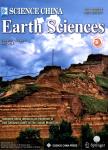Biomarker evidence for changes in terrestrial organic matter input into the Yellow Sea mud area during the Holocene
Biomarker evidence for changes in terrestrial organic matter input into the Yellow Sea mud area during the Holocene作者机构:Key Laboratory of Marine Chemistry Theory and TechnologyMinistry of EducationOcean University of ChinaQingdao 266100China Key Laboratory of Marine Hydrocarbon Resources and Environmental GeologyMinistry of Land and ResourcesQingdao 266071China Third Institute of OceanographyState Oceanic Administration(SOA)Xiamen 361005China College of Marine GeoscienceOcean University of ChinaQingdao 266100China
出 版 物:《Science China Earth Sciences》 (中国科学(地球科学英文版))
年 卷 期:2016年第59卷第6期
页 面:1216-1224页
核心收录:
学科分类:070903[理学-古生物学与地层学(含:古人类学)] 0709[理学-地质学] 07[理学] 0708[理学-地球物理学] 0704[理学-天文学]
基 金:supported by the National Natural Science Foundation of China(Grant No.41221004) the Key Laboratory of Marine Hydrocarbon Resources and Environmental Geology of the Ministry of Land and Resources(Grant No.MRE201301) the National Basic Research Program of China(Grant No.2010CB428901) the“111”Project(Grant No.B13030)
主 题:South Yellow Sea Holocene Biomarker Marine organic matter Terrestrial organic matter
摘 要:We present lipid biomarker records of two cores (ZYI and ZY3) from the central South Yellow Sea mud area to investigate the changes in sources and transport processes of the sedimentary organic matter (OM) throughout the Holocene. Based on the analysis of marine biomarker content (EPB (Phytoplankton Biomarker, total content of brassicasterol, dinosterol and C37-alkenones) and crenarchaeol), and terrestrial biomarkers (En-alkanols and brGDGTs) as well as TMBR' and BIT index values, the marine organic matter (MOM) and terrestrial organic matter (TOM) deposition history was reconstructed. Changes in TOM and MOM were related to variations in land vegetation density and marine productivity, as well as transport processes dominated by the oceanic circulation system. The marine biomarker contents from the South Yellow Sea have generally in- creased throughout the Holocene, indicating that the increased MOM contents were mainly controlled by the strengthening of the circulation system. The terrestrial biomarkers, on the other hand, were more variable, indicating more complex influence of TOM burial in the Yellow Sea. During the Early Holocene (7200-6000 cal yr BP), the moderate TOM input revealed by the terrestrial proxy records may result from abundant land source supply by strong river transport despite the lack of transport via circulation system. The Mid-Holocene (6000-3000 cal yr BP) was characterized by decreased terrestrial biomarker contents. The balance between the decrease in land source supply and increase of transportation by the current system of the TOM resulted in the lower but stable contents of TOM. During the Late Holocene (3000 cal yr BP to present), the TOM deposition in the South Yellow Sea increased as the current system was further enhanced and thus transported more TOM to the central South Yellow Sea, although the land supply of TOM was further reduced.



